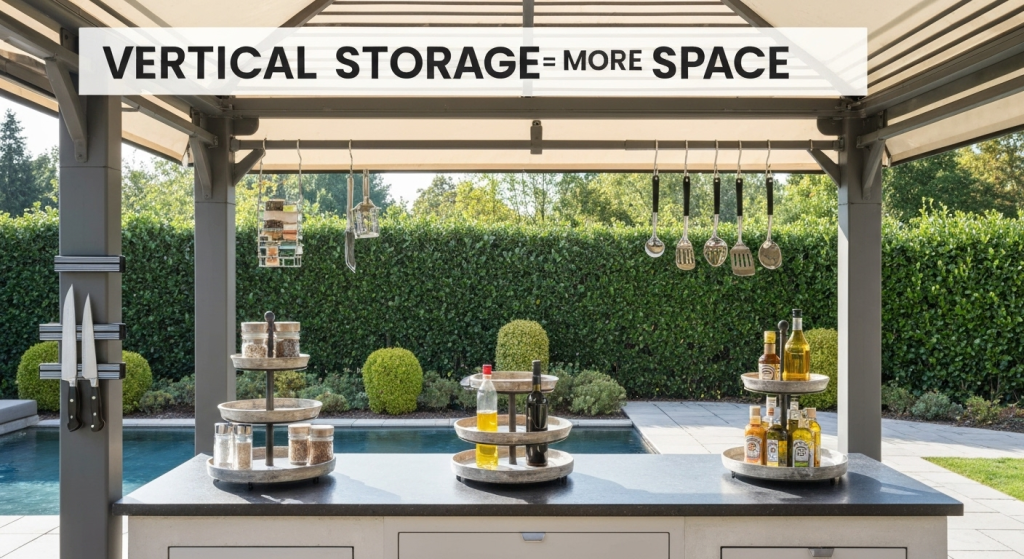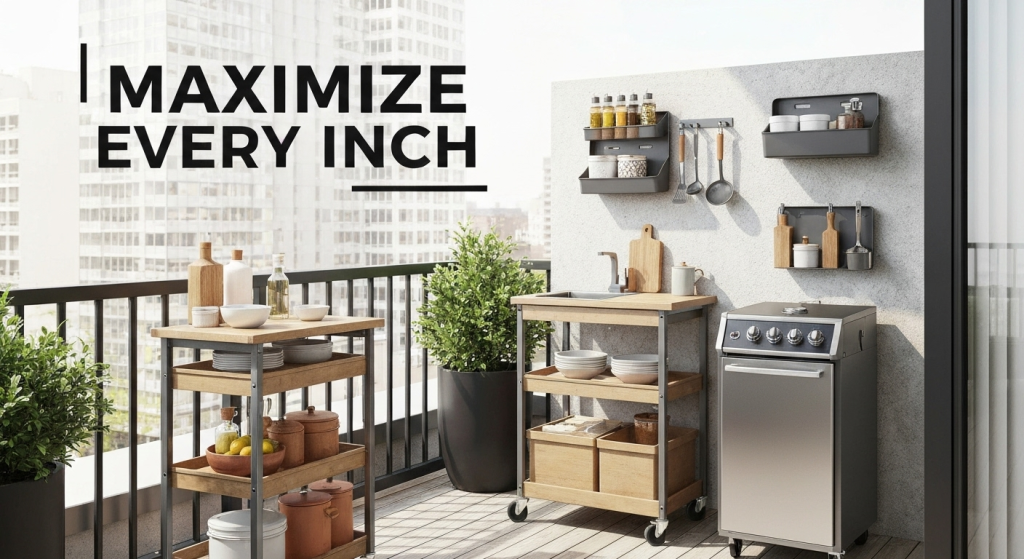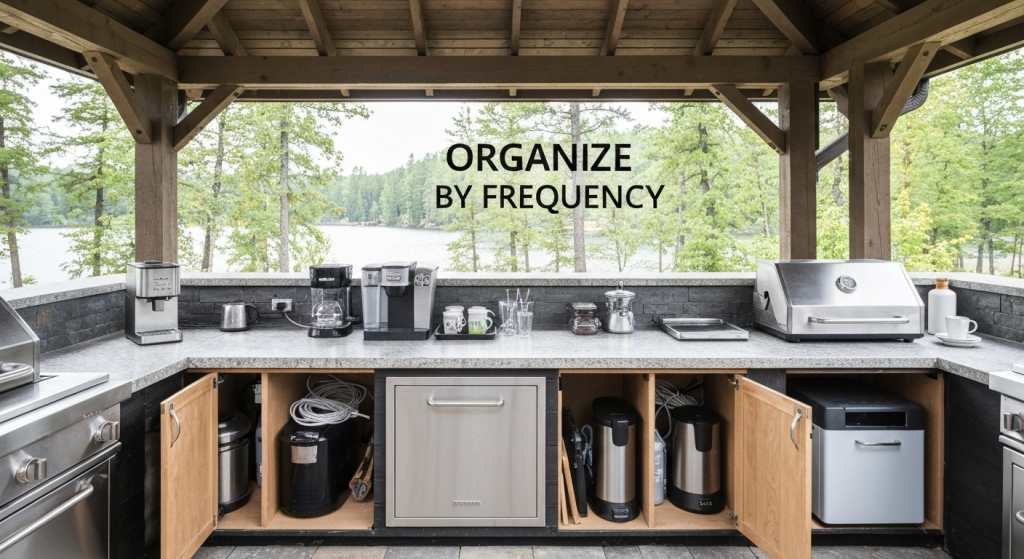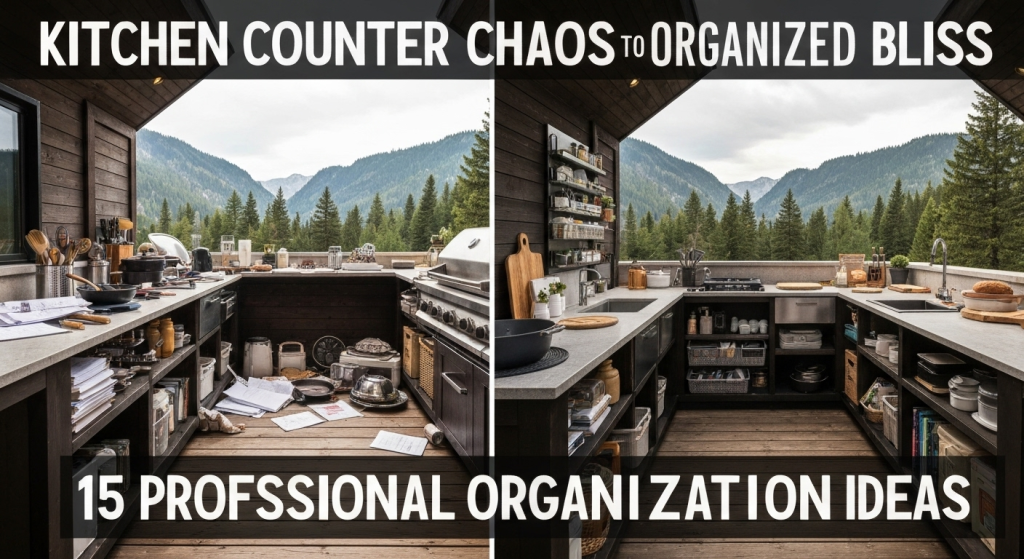Kitchen counter clutter drives me crazy. After five years as a professional home organizer, I’ve seen countless kitchens transform from chaotic disaster zones into calm, functional spaces. The secret isn’t buying more storage containers—it’s understanding how your kitchen really works.
My name is Richard Boren, and I’ve spent half a decade helping families reclaim their kitchen counters. From tiny studio apartments to sprawling suburban homes, I’ve learned that counter organization follows specific principles that work every time. These aren’t just theoretical tips—they’re battle-tested strategies I use in real homes every day.
The kitchen counter problem affects 85% of American households, according to recent home organization surveys. But here’s what most people don’t realize: cluttered counters aren’t just an aesthetic issue. They slow down meal prep, increase stress levels, and make cooking feel like a chore instead of a joy.
Why Kitchen Counter Organization Matters More Than You Think
Counter space directly impacts how you cook and live. When I walk into a client’s kitchen, I can predict their stress level just by looking at their counters. Clear counters equal clear minds—and faster meal preparation.
Cluttered counters create several hidden problems:
Your cooking time increases by an average of 15-20 minutes per meal when you’re constantly moving items around. You avoid cooking at home more often, leading to higher food costs and less healthy eating habits. The visual chaos creates mental fatigue that affects your entire day.
But organized counters do the opposite. They make cooking enjoyable again. Meal prep becomes efficient. Your kitchen feels bigger and more welcoming.
The Three-Zone System: My Proven Method

Every functional kitchen needs three distinct zones on the counters. This system works regardless of kitchen size or layout. I’ve used it in galley kitchens and open-plan spaces with equal success.
Zone 1: The Active Cooking Area
This zone sits directly in front of your stove and primary prep space. Keep only items you use while actively cooking. Think salt, pepper, olive oil, and your most-used spatula.
What belongs here:
- Daily cooking oils and vinegars
- Salt and pepper mills
- One wooden spoon or spatula
- Small cutting board for quick tasks
What doesn’t belong here:
- Decorative items
- Appliances you use weekly or less
- Mail or papers
- Keys or personal items
Zone 2: The Prep Station
Located near your sink and main cutting board area, this zone handles food preparation tasks. Keep prep tools and ingredients within arm’s reach of where you chop, slice, and mix.
Essential items for this zone:
- Knife block or magnetic strip
- Cutting boards (stored vertically)
- Prep bowls
- Kitchen scale (if used regularly)
Zone 3: The Service Area
This zone near your dining area or breakfast bar handles plating, serving, and quick snacks. It bridges the gap between cooking and eating.
What works here:
- Coffee station supplies
- Fruit bowl
- Serving pieces you use weekly
- Water filter or pitcher
Smart Storage Solutions That Actually Work

After organizing hundreds of kitchens, certain storage solutions consistently deliver results. These aren’t trendy Instagram-worthy containers—they’re practical tools that make daily life easier.
Vertical Storage Maximizes Space
Most people think horizontally, but smart organizers think vertically. Wall-mounted solutions free up precious counter real estate while keeping essentials accessible.
Magnetic strips work for more than just knives. I use them for spice jars with metal lids, small tools, and even measuring spoons. They’re perfect for renters who can’t install permanent fixtures.
Under-cabinet hooks hold mugs, measuring cups, and lightweight tools. Install them on the underside of upper cabinets to utilize dead space.
Tiered stands create multiple levels on your counter without taking up more footprint. Use them for spices, oils, or frequently used condiments.
| Storage Solution | Best For | Counter Space Saved | Installation Difficulty |
|---|---|---|---|
| Magnetic strips | Knives, spice jars, tools | High | Easy |
| Under-cabinet hooks | Mugs, measuring cups | Medium | Easy |
| Tiered stands | Spices, condiments | Low | None |
| Wall-mounted racks | Paper towels, wraps | High | Medium |
The Container Strategy
Not all containers are created equal. I’ve wasted clients’ money on beautiful jars that didn’t improve function. The best containers share specific characteristics.
Clear containers let you see contents at a glance. No more opening five containers to find the right ingredient. Square or rectangular shapes use space more efficiently than round ones.
Airtight seals keep ingredients fresh longer. This isn’t just about cereals and snacks—even spices stay fresher in sealed containers.
Stackable designs multiply your storage capacity vertically. But here’s the key: you still need to access everything easily. If you’re unstacking three containers to reach one ingredient, the system fails.
Daily Habits That Maintain Organization
Organization systems fail without supporting habits. The most beautiful setup crumbles in weeks without the right daily routines.
The Five-Minute Reset
Every evening, spend five minutes returning items to their designated zones. This isn’t deep cleaning—it’s maintenance. Load the dishwasher, wipe counters, and put stray items back where they belong.
This habit prevents the slow accumulation of clutter that eventually overwhelms your system. I’ve seen clients maintain perfect counter organization for years with just this simple routine.
The One-Touch Rule
When you use something, put it back immediately after use. Don’t set it down “temporarily” on the counter. That temporary placement becomes permanent faster than you think.
This rule applies especially to:
- Cooking oils and seasonings
- Kitchen tools and utensils
- Mail and papers (which shouldn’t be on counters anyway)
- Personal items like keys or phones
Weekly Audit Sessions
Once a week, do a quick audit of your counter zones. Are items creeping into the wrong areas? Has clutter started accumulating again? Address these issues before they become bigger problems.
During these audits, also check that your frequently used items are still in the most convenient locations. Your cooking habits change seasonally, and your organization should adapt accordingly.
Common Organization Mistakes to Avoid
Even well-intentioned organizers make predictable mistakes. I’ve seen these errors countless times, and they always lead to system failure.
Mistake 1: Over-Organizing
Some clients want a container for everything. But excessive organization creates more work than it eliminates. If opening three containers and using two tools just to get salt becomes your routine, you’ve gone too far.
The solution: Organize only what needs organizing. Keep frequently used items easily accessible, even if it looks slightly less perfect.
Mistake 2: Ignoring Your Actual Habits
Beautiful organization systems fail when they don’t match real behavior. If you always grab your coffee mug from the dishwasher instead of the cabinet, put the mug storage closer to the dishwasher.
The solution: Design your system around your current habits first. Change habits second, if needed.
Mistake 3: All-or-Nothing Thinking
Many people think they need to organize their entire kitchen in one weekend. This leads to burnout and abandoned systems.
The solution: Focus on one zone at a time. Perfect that zone completely before moving to the next one.
| Common Mistake | Why It Fails | Better Approach |
|---|---|---|
| Too many containers | Creates extra steps | Organize only what’s necessary |
| Ignoring habits | System doesn’t match reality | Design around current behavior |
| All-or-nothing | Leads to burnout | One zone at a time |
| Perfect aesthetics | Function suffers | Prioritize ease of use |
Small Kitchen Counter Solutions

Small kitchens require different strategies. You can’t just scale down big kitchen advice—you need fundamentally different approaches.
Maximize Every Inch
In small kitchens, every surface counts. Use the sides of your refrigerator for magnetic storage. Add shelves above the counter if wall space permits. Install hooks inside cabinet doors.
Rolling carts serve as portable counter extensions. Roll them out during meal prep, then tuck them away when not needed. Look for carts with solid tops that can handle chopping and mixing tasks.
Multi-Purpose Everything
Small kitchen items must earn their counter space by serving multiple functions. A large cutting board doubles as a serving tray. A beautiful bowl holds fruit and serves guests. Nesting bowls save storage space while providing multiple sizes.
Kitchen scales that store flat take up minimal space but add significant functionality. Digital models often include timers and unit conversion features.
Strategic Minimalism
Small kitchens force you to choose only essential items. This limitation actually improves functionality because you keep only what you truly use.
Apply the 80/20 rule: you probably use 20% of your kitchen items 80% of the time. Identify that crucial 20% and give those items prime counter real estate.
Appliance Organization Strategies

Kitchen appliances create the biggest counter clutter challenges. Most people own twice as many appliances as they regularly use, and store them poorly.
The Frequency Test
Sort appliances by usage frequency:
- Daily use: Coffee maker, toaster
- Weekly use: Blender, stand mixer
- Monthly use: Food processor, rice cooker
- Occasional use: Specialty items
Only daily-use appliances earn permanent counter space. Everything else gets stored in cabinets or pantries.
Appliance Garages
Appliance garages hide countertop appliances behind cabinet doors while keeping them plugged in and ready to use. These work especially well for coffee stations or frequently used small appliances.
If you can’t install appliance garages, create designated storage areas in lower cabinets. Use pull-out shelves to make retrieval easier.
Cord Management
Appliance cords create visual clutter even when the appliances look organized. Use cord clips to route cords along cabinet edges or behind appliances.
For permanently placed appliances, consider installing additional outlets in convenient locations to eliminate cord stretching across counters.
Seasonal Organization Adjustments
Your kitchen organization needs change throughout the year. What works in summer might not work in winter when you’re cooking heartier meals and using different ingredients.
Holiday Preparations
During holiday seasons, temporarily relocate some everyday items to make room for special baking supplies or serving pieces. Store your regular coffee setup to make space for holiday cookie ingredients.
Create a “holiday box” for items you only use during specific seasons. This prevents special-occasion items from cluttering your year-round organization.
Seasonal Ingredient Swaps
Rotate spices and condiments based on seasonal cooking patterns. Summer might feature grilling seasonings and fresh herb storage. Winter might emphasize baking spices and hearty soup ingredients.
This rotation keeps your most relevant ingredients in the prime spots while storing off-season items elsewhere.
Advanced Organization Techniques
Once you’ve mastered basic counter organization, these advanced techniques can further improve your kitchen’s functionality.
The Landing Strip Method
Create a designated “landing strip” near your kitchen entrance for items that temporarily need counter space. Mail, keys, and grocery bags get sorted here before moving to their permanent homes.
This prevents these items from spreading across your organized zones while providing a specific processing area.
Color Coordination
While not essential, color coordination can improve the visual appeal of your organized counters. Group similar colored items together or choose storage containers in complementary colors.
Black and white schemes work well because they coordinate with most kitchen finishes. Natural materials like wood and bamboo add warmth without clashing.
The Two-Week Test
After implementing any new organization system, use it for exactly two weeks without changes. This gives you enough time to identify what works and what doesn’t before making adjustments.
Keep notes about what frustrates you or slows you down. These observations guide your refinements.
Maintenance and Long-Term Success
The best organization system is the one you’ll actually maintain. Long-term success requires building sustainable habits and regular system reviews.
Monthly Reviews
Once a month, evaluate your organization system’s effectiveness. Are you consistently putting items back in their designated spots? Are certain areas accumulating clutter despite your efforts?
Use these reviews to make small adjustments before problems become major overhauls.
Family Buy-In
If you share your kitchen, every household member needs to understand and follow the organization system. Take time to explain the logic behind your zones and storage decisions.
Label everything during the first few weeks to help family members learn the new system. Remove labels once the habits are established.
Evolution Over Time
Your organization needs will change as your cooking habits evolve, family size changes, or you acquire new appliances. Don’t be afraid to modify your system when life circumstances change.
The goal is a functional kitchen that supports your lifestyle, not a museum display that looks perfect but doesn’t work for daily use.
Frequently Asked Questions
How long does it take to organize kitchen counters properly?
For most kitchens, plan one full weekend for the initial organization. Day one involves decluttering and sorting items by frequency of use. Day two focuses on implementing storage solutions and creating your zone system. Expect 2-4 weeks for new habits to feel natural.
What’s the biggest mistake people make when organizing counters?
Trying to make everything look perfect instead of focusing on function. I’ve seen beautiful Pinterest-worthy kitchens that are impossible to cook in because accessing basic items requires moving three containers and opening two cabinets. Prioritize ease of use over appearance.
How do I keep counters organized when I’m busy?
Stick to the five-minute evening reset rule. Even on the busiest days, you can spend five minutes putting items back in their zones. This prevents clutter accumulation and maintains your system with minimal effort.
Should I store frequently used appliances on the counter?
Only if you use them daily. Weekly-use appliances should be stored in easily accessible cabinets. The counter space they free up is usually more valuable than the convenience of having them always visible.
Conclusion
Kitchen counter organization isn’t about perfection—it’s about creating systems that make cooking easier and more enjoyable. After five years of helping families transform their kitchens, I’ve learned that the best organization systems feel invisible. They work so well that you stop thinking about organization and start focusing on creating great meals.
Start with the three-zone system and build from there. Focus on function over appearance. Give yourself time to develop new habits. Most importantly, remember that your organization system should serve your lifestyle, not the other way around.
Your kitchen counters can become the calm, functional space you’ve always wanted. It just takes the right approach and consistent daily habits. The investment of time and effort pays dividends every single day in reduced stress and increased cooking enjoyment.



